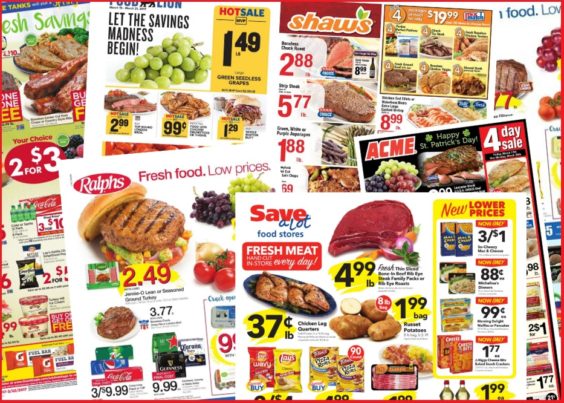
Which came first – the chicken or the egg? Or, in the case of coupons, which came first – fewer coupons, or fewer coupon users?
You could make the argument either way – because fewer people are interested in clipping coupons these days, fewer coupons are being issued in response, or because fewer coupons are being issued, fewer people are using them.
Regardless of the precise cause-and-effect, a recent report on the state of coupons and promotions finds that coupon use and deal-seeking continue to decline. But retailers and manufacturers could be missing out if they don’t do something to help reverse this trend.
For the seventh year, the research firm TABS Analytics is out with its annual Food and Beverage Consumables Study, which gauges consumer behavior based on a survey of 1,000 consumers. Among the insights in this year’s report is that shoppers’ use of traditional savings methods has plummeted to all-time lows. And, whether by choice or otherwise, the number of shoppers who consider themselves dedicated deal seekers is on the decline as well.
In 2013, the first year of TABS’ survey, 45% of shoppers reported using coupons they had clipped from the Sunday newspaper inserts. Aside from a small uptick last year, that percentage has been on the decline ever since – and this year, it plummeted to just 20%. That corresponds with other recent reports’ findings that the number of coupons available has also plunged to new lows.
Surely, that must be because more shoppers are using digital coupons instead of paper. Well, not quite. The use of digital coupons peaked at 38% in the first year of the survey, and has now dipped to an all-time low of 28%. That, too, is in line with other recent reports, which have found that digital coupons’ once-meteoric rise is now slowing down considerably.
As coupon use falls out of favor, the only other deal-seeking tactic to see a similar decline is the use of grocery circulars. 50% of shoppers used them in 2013, and now that percentage has fallen to a low of 34%.
TABS blames some of the changes on the decline in newspaper readership. After all, fewer newspaper buyers means fewer shoppers are getting coupons from the Sunday inserts or consulting their stores’ weekly printed sales circulars. But it’s not just that. Fewer shoppers are actively working to save money at all.
That’s not because they’re not interested in saving money anymore. Instead, TABS says more shoppers are shifting to what it calls “passive deal tactics,” or savings methods that don’t require any particular effort. Buying groceries at stores with everyday low prices, like Walmart or ALDI, instead of clipping coupons and seeking out weekly specials at the local grocery store, remains the most popular passive deal tactic, with 59% of shoppers reporting that they look to save money that way. Other passive deal tactics, like purchasing less-expensive store brands or buying in bulk, “gained significant traction,” TABS found.
Further illustrating that trend, it seems fewer of us are buying all of our groceries at the grocery store. As recently as 2016, grocery stores earned nearly one-quarter of the total grocery market share. Today, that percentage is down to 15.4%, barely ahead of Walmart’s 13.5%. That’s not to say that no one goes to a traditional grocery store anymore – 80% of people say they still regularly shop there. But more people are shopping around, and getting the rest of their groceries at other stores that are more convenient, offer a different selection, or have lower everyday prices.
In fact, out of 15 retailers and retail channels tracked by TABS – from big-box stores to club stores, dollar stores to drug stores – every single one of them saw an increase in the number of shoppers who say they shop there regularly. That means more of us are visiting more stores more often, but buying fewer items in each place. Maybe you go to the grocery store to grab what’s on sale, then swing by ALDI later in the week for cheap produce, visit a dollar store the next day for inexpensive personal items, and head to Walmart for whatever else is still on your list.
In the end, that could be a very active way to save passively – visiting a bunch of different stores in order to take advantage of the best prices at each one. As a savings strategy, that certainly takes time – but then so does clipping coupons and studying the weekly sales circulars.
Overall, TABS found that fewer people are considered “heavy deal users,” or those who take advantage of at least six different types of deal tactics. While a third of all shoppers were heavy deal users in the first year of the survey, only 21% are now.
Retailers and manufacturers may breathe a sigh of relief that shoppers aren’t hunting for low prices the way they used to. But TABS says that would be a mistake. Heavy deal users, it says, are also among the heaviest buyers. “We still see a very high relationship between high deal engagement and heavy category buying,” the report found. In other words, deal seekers can be a store’s or a brand’s best customers. And if stores and brands can’t keep those customers engaged by offering attractive coupons or sales, those deal seekers may well do more of their shopping somewhere else.
So good coupons may be harder to find these days. But don’t give up. If more deal-seekers keep visiting more stores in order to avoid paying full price – coupons just might be due for a comeback.











Someone send this to Shoprite. I’ve spend $1,000s less there since their coupon policy changes. I used to go out of my way to promote them and bring my business to them even if I didn’t need to (Giftcards, Pharmacy, etc) because of their great perk of combining Digital & Paper coupons, but not anymore. They took the lazy way out. They peanalized their most loyal shoppers who followed the rules, when they could have easily put checks in place to deny the clear and obvious abusers, who would have been the more appropriate target.
“Retailers and manufacturers may breathe a sigh of relief that shoppers aren’t hunting for low prices the way they used to. But TABS says that would be a mistake. Heavy deal users, it says, are also among the heaviest buyers. “We still see a very high relationship between high deal engagement and heavy category buying,” the report found. In other words, deal seekers can be a store’s or a brand’s best customers. And if stores and brands can’t keep those customers engaged by offering attractive coupons or sales, those deal seekers may well do more of their shopping somewhere else.”
This is so true. Take note of it.
I’m having trouble getting decent coupons in my Sunday papers. My local paper (Westchester Journal News) no longer gets Kimberly-Clark (Scott, Cottonelle, Huggies) or General Mills coupons in the Smartsource insert. The Retail Me Not insert doesn’t get a number of coupons that I see listed in other people’s inserts. I have no idea why the manufacturers did this or who to complain to (or if there’s even a way to complain)
The New York Times stopped getting the RMN insert entirely a few months ago (not a huge loss since it always had a very poor copy with many coupons missing). It doesn’t get the Smartsource insert at all ever since Smartsource (owned by the parent company of the WSJ) took them away from the Times a few years ago and put them in the weekend WSJ instead.